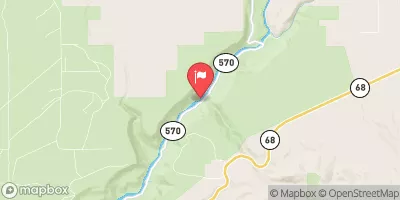Summary
The area is home to various trout species, including rainbow, brown, and brook trout, making it a must-visit for avid anglers.
Apart from fishing, visitors can indulge in various activities such as hiking, camping, and wildlife spotting. The fishing area is surrounded by the Carson National Forest, providing a serene environment for outdoor enthusiasts.
Fishing tips for Rito De La Olla Fishing area include using lightweight gear, as the area has small streams and creeks. Live bait, such as worms and insects, can also be productive.
The best time of year to visit Rito De La Olla Fishing area is during the summer months of June to August when the weather is warm and pleasant. The average temperature during this time is around 74°F, making it ideal for outdoor activities.
In conclusion, Rito De La Olla Fishing area is a fantastic destination for anglers and outdoor enthusiasts. With its diverse fish species and nearby activities, visitors can have an unforgettable experience while enjoying the pristine beauty of New Mexico's wilderness.
Weather Forecast
Nearby Streamflow Levels
Angling Safety Guidelines
Check local fishing rules, seasons, size limits, and license requirements to ensure legal and sustainable angling.
Handle Fish Responsibly
Use wet hands, minimize air exposure, and release fish gently to improve survival rates when practicing catch-and-release.
Choose the Right Gear
Match your rod, line, and tackle to the species and conditions to increase success and reduce unnecessary harm to fish.
Respect the Waterway
Avoid disturbing habitat, prevent bank erosion, and keep a safe distance from spawning areas to protect ecosystems.
Keep It Clean
Pack out all line, hooks, bait containers, and trash—discarded gear can injure wildlife and degrade waterways.
Related Links
Area Campgrounds
| Location | Reservations | Toilets |
|---|---|---|
 Comales
Comales
|
||
 Comales Campground
Comales Campground
|
||
 Llanito Frio Campground
Llanito Frio Campground
|
||
 Las Petacas Campground
Las Petacas Campground
|
||
 Las Petacas
Las Petacas
|
||
 La Sombra Campground
La Sombra Campground
|

 Rio Chiquito Fishing
Rio Chiquito Fishing
 Rio Fernando Fishing
Rio Fernando Fishing






 Rc&D Project Measure 83 Dam
Rc&D Project Measure 83 Dam
 Taos Junction Bridge Boat Takeout
Taos Junction Bridge Boat Takeout
 Taos Junction Bridge Boat Launch
Taos Junction Bridge Boat Launch
 Taos Junction Bridge Taos County
Taos Junction Bridge Taos County
 Lone Juniper Boat Takeout
Lone Juniper Boat Takeout
 Lone Juniper Boat Launch
Lone Juniper Boat Launch